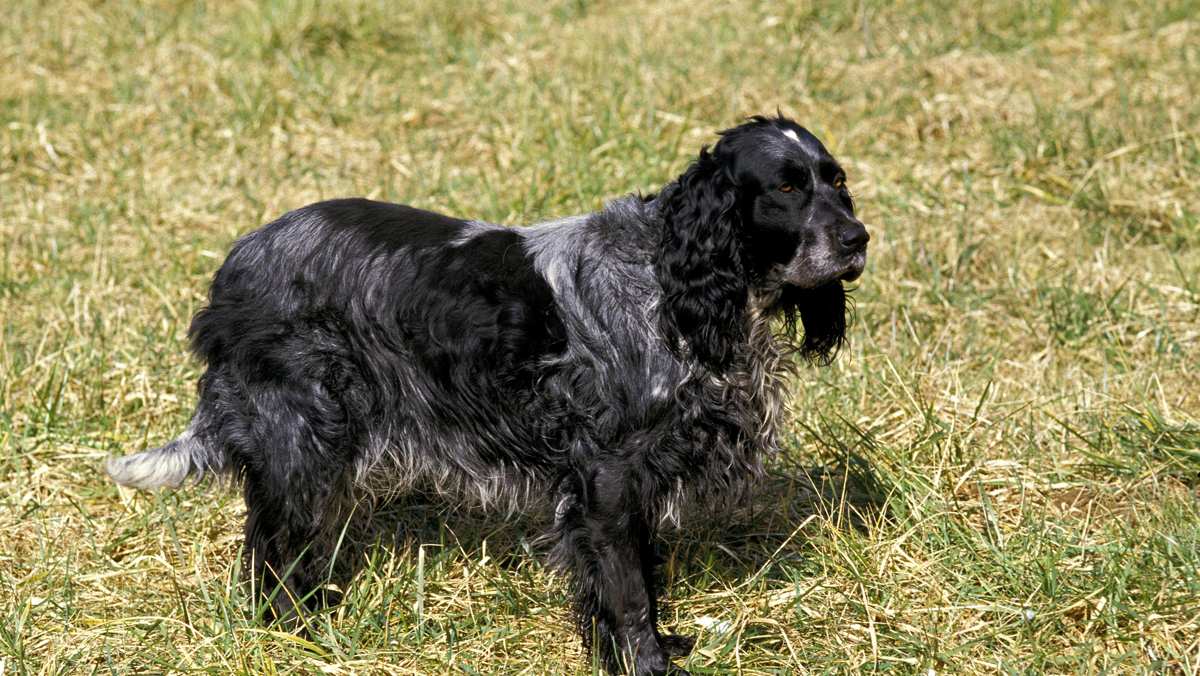Blue Picardy Spaniel Breed Details
Below are details and specs for the Blue Picardy Spaniel dog breed.

The Blue Picardy Spaniel originated in the Picardie region of France as a result of breeding between Picardy Spaniels and English Setters. France and Canada are the main places this breed is found. Its original purpose was for hunting waterfowl, although it makes a good hunting dog for most game and is an excellent companion dog as well. It is a medium sized dog, whose notable features include blue pigmented skin and a grey-black speckled coat that blends to a bluish hue. This dog can be described as quiet, playful, highly trainable, and resilient. It gets along well with children and other animals. The grooming needs of this breed are low, but requires a large amount of exercise. It is very versatile, being well suited to most environments and temperatures. There are no major health issues documented for the breed and the life expectancy is 13 years.
Below are details and specs for the Blue Picardy Spaniel dog breed.
The Blue Picardy Spaniel is a medium sized dog, generally being 22-24 inches tall at the shoulders and weigh 43-45 pounds.
Members of this breed are docile, gentle, playful, intelligent, obedient, and resilient dogs with a strong desire for work and companionship. They are excellent with children as well as other pets in the household.
The maintenance needs for these dogs is low for grooming and high for the amount of exercise required. A weekly brushing and extra attention for signs of ear infection are sufficient to meet the grooming needs. Daily exercise is recommended to due to the high level of stamina they exhibit.
The Blue Picardy Spaniel descends from the Picardy Spaniel, resulting from the breeding of the Picardy Spaniels with English and Gordon Setters. It is considered to be a distinct breed due to its blue skin and the gray-black mottled coat. The breed originated in France and is found predominantly in France and Canada. French spaniels date back to the eleventh century, as a result of European pointers brought during the Crusades breeding with Arabian greyhounds. These spaniels began to differentiate among the various regions of France, based on traits better suited hunting in the specific regions. In Picardie, especially near the Bay of Somme, the abundant waterfowl led to the spaniels of this region being well suited for hunting these birds. By 1938, the Blue Picardy Spaniel was officially recognized as distinct breed in Europe. It was recognized as a breed by the Canada Kennel Club in 1995.
This is a medium sized dog with a similar appearance to the Picardy Spaniel and some characteristics of setters. It has a long muzzle, a lengthy muzzle, medium depth chest, and a straight tail that reaches just past the ankle. The ears are wide and pendulous, starting slightly above eye level and extending long enough to reach the muzzle. The coat of this breed is gray and black speckled, which results in a bluish color. The skin is also blue in pigment. Its hair is soft, wavy, and feathered on ears and tail.
The images below represent the coat colors and patterns associated with Blue Picardy Spaniels.

Blue Picardy Spaniels are notable for being a generally docile and gentle breed, while also being playful. They are obedient and have a strong desire to work, along with high intelligence and trainability. These traits combined with a high stamina and resilience to harsh environments make them excellent hunting dogs. They are very responsive and have a strong desire for human companionship, making them ill-suited to being left alone for long periods.
These dogs are considered low maintenance breed for grooming, but high maintenance for energy. A weekly brushing will keep the coat looking presentable, although special attention should be given to the ears since they are susceptible to ear infection. Considering the high stamina which makes them efficient hunting dogs, the breed will require daily exercise. They are intelligent and eager to please, making them highly trainable.
Blue Picardy Spaniels require a minimal amount of grooming. Brushing once a week is sufficient to keep the coat in good appearance. As with other dogs that have pendulous ears, they are prone to getting ear infections. To help prevent infections, the ears should be dried after the dog has been in water and should be cleaned regularly.
This breed is typically docile, but needs a high amount of exercise due to its high stamina. They are resilient, tireless, and can easily be trained to be hunting and sporting dogs. A moderate amount of exercise, including at least a daily walk, is required to maintain wellness.
One of the traits these dogs were bred for is ability to withstand adverse weather conditions for hunting, which makes them acclimated to harsh environments. They thrive as indoor dogs, though, due to their desire for human companionship. They are suitable for living in apartments, as long as their daily exercise requirements can be met.
Similar to all dogs with large, pendulous ears, this breed is susceptible to ear infections. There are no serious health issues documented with this breed and the life span is typically 13 years.
Below are potential health concerns associated with Blue Picardy Spaniels.